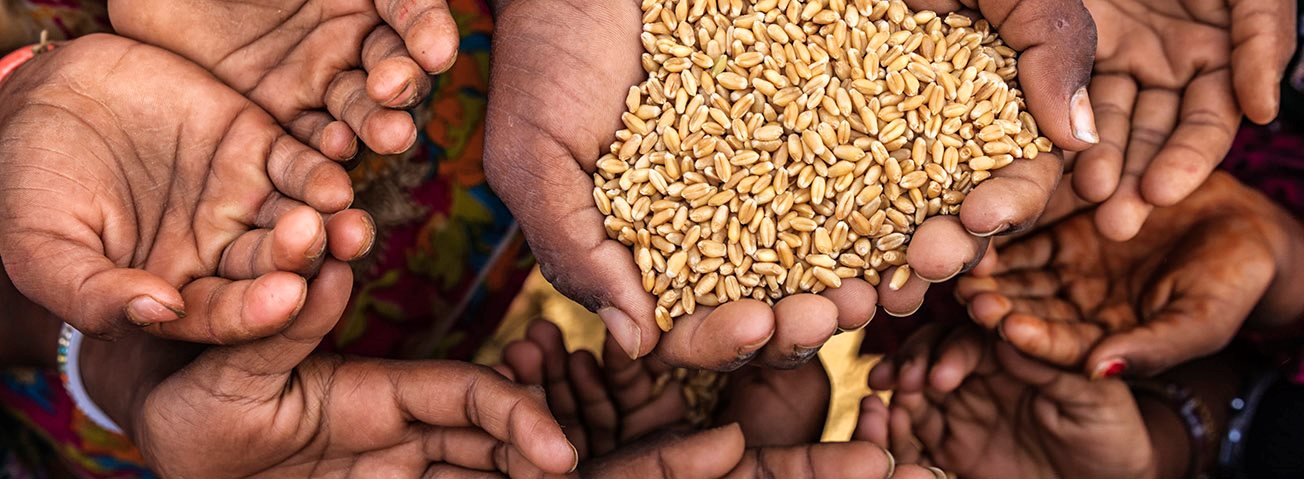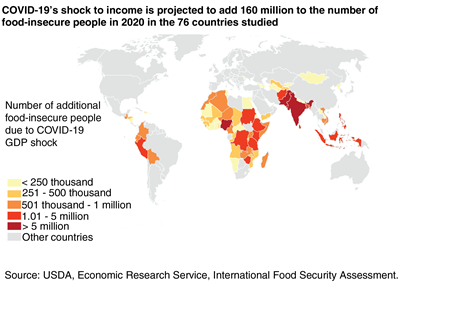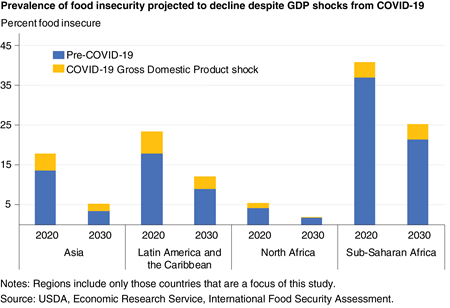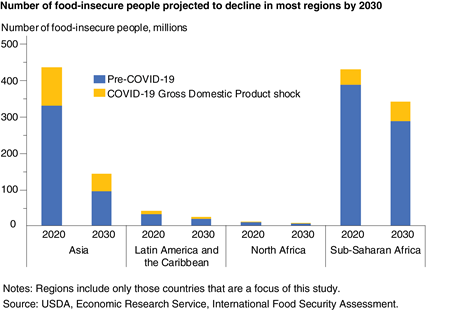International Food Security to Improve by 2030; COVID-19 Related Income Declines in 2020 Temper Overall Improvement

Highlights:
-
The number of food-insecure people around the world in 2020 is estimated at 921 million, a figure that would have been 21 percent smaller if it were not for income losses resulting from the COVID-19 pandemic. This means that nearly one-fourth of a total population of 3.8 billion people living in low- and middle-income countries may not have consistent access to the daily caloric target of 2,100 calories.
-
Per capita income in the coming decade is projected to increase 3.3 percent on average for the 76 countries studied. Although an overall improvement, it is 6 percent lower because of the impact of COVID-19.
-
By 2030, the share of the population that is food insecure in the 76 countries is projected to fall to 11.6 percent (513 million people), which is a 44-percent drop from 2020. Even with the sharp decline, the 2030 estimate of food insecurity is almost 27 percent higher than the pre-COVID-19 scenario.
Hundreds of millions of people around the world are food insecure. Income, food prices, and economic inequality are major determinants of how much access people have to food, while agricultural production and market conditions affect how much food is available. Widespread food availability, rising income levels, and low food prices improve a country’s food security. Conversely, shocks to income, prices, or food supply can decrease food security, especially for the poor.
Each year, the USDA, Economic Research Service (ERS) report International Food Security Assessment, 2020-2030 (IFSA) uses these determinants to analyze food security conditions in 76 low- and middle-income countries, all of which are historic or current food aid recipients. Special to this year’s report is an analysis of the effect of income losses associated with the COVID-19 pandemic on present and future food security.
The IFSA uses a model to project food demand based on changing income levels and food prices in the 76 countries through 2030. Food insecurity is evaluated for each country by estimating the share of the population that is unable to reach a caloric target of 2,100 calories per person per day. That average daily calorie level, set by the United Nations, is an internationally accepted recommendation for sustaining a healthy and active lifestyle. The food gap, defined as the amount of food needed for all food-insecure people to reach the caloric target, indicates the intensity of food insecurity.
More than One-Fifth of a Population of 3.8 Billion May Lack Access to Sufficient Caloric Intake
The ERS food security model shows that for 2020, the number of food-insecure people is estimated at 921 million. This would mean that 24 percent of the total population of 3.8 billion in the 76 countries studied is unable to access 2,100 calories a day. When researchers factor COVID-19 into the scenario, the estimated number of food-insecure people is 21 percent higher than it would have been otherwise, driven by declines in income associated with drops in gross domestic product (GDP)—the value of goods and services generated in the countries studied. Most of the additional 160 million people estimated to be food insecure because of COVID-19-related declines in GDP are in Asia (106 million) and Sub-Saharan Africa (42 million) (see figure below).
Notwithstanding the GDP impact from COVID-19, anticipated future income growth, relatively stable food prices, and greater macroeconomic stability in the coming decade are projected to reduce the share of the population that is food insecure in the 76 countries to 11.6 percent by 2030 and the total number of food-insecure people in those countries to 513 million. However, estimates put the number of food-insecure people in 2030 at 56 million more than it would have been had the worldwide economic downturn caused by the pandemic not occurred.
Demand for food in the countries studied is expected to grow at an annual rate of 2.6 percent from 2020 to 2030, compared with 2.0 percent for food production, as world food prices remain low and incomes begin to rise over the medium term. Trade has a vital role in addressing the gap between demand and production in the 76 countries, assuring more food security in the coming decade.
Income Per Capita To Increase Despite Drag From COVID-19, Improving Food Security
Low food prices and rising incomes can improve a country's food security situation by enabling people to more readily afford and access food. This year’s IFSA examines the effect of income shocks by providing projections for both pre- and post-COVID-19 conditions and compares the difference between them to assess the impact of the pandemic on food security.
The 76 countries examined in the IFSA are divided into four major regions: Sub-Saharan Africa, Asia, Latin America and the Caribbean, and North Africa. Although income growth over the coming decade is projected to be positive for all regions, in absolute terms, GDP levels are lower both in 2020 and 2030 because of the income shock from COVID-19.
The highest shocks to GDP per capita in 2020 from COVID-19 are in Latin America and the Caribbean (down 11.8 percent) and Asia (down 10.6 percent). But these two regions have the highest GDP per capita of the four regions studied. By contrast, GDP per capita in Sub-Saharan Africa is the lowest in the sample and is projected to decline 6.3 percent in 2020. In North Africa, GDP per capita in 2020 due to COVID-19 is projected to decline by 5.7 percent.
The Asian countries examined in the IFSA are projected to have the highest relative increase in GDP per capita (53 percent) in the coming decade, while the Sub-Saharan Africa countries examined are projected to have the lowest (15 percent), mostly reflecting high population growth in the Sub-Saharan Africa.
| Per Capita Gross Domestic Product (GDP) | 2020 | 2030 | Change 2020/ 2030 |
|---|---|---|---|
| Asia | $2,225 | $3,411 | 53.3% |
| Change from pre-COVID-19 estimate | -10.6% | -12.9% | |
| Latin America and the Caribbean | $4,974 | $6,238 | 25.4% |
| Change from pre-COVID-19 estimate | -11.8% | -11.4% | |
| North Africa | $3,436 | $4,226 | 23.0% |
| Change from pre-COVID-19 estimate | -5.7% | -4.3% | |
| Sub-Saharan Africa | $1,215 | $1,393 | 14.6% |
| Change from pre-COVID-19 estimate | -6.3% | -8.7% | |
|
Notes: Value in 2010 U.S. dollars to adjust for inflation. Regions include only those countries that are a focus of this study. Source: USDA, Economic Research Service, International Food Security Assessment. |
|||
Higher food availability and lower food prices will improve a country’s food security. As projected in ERS’s Agricultural Baseline Data, world agricultural production will continue to outpace demand over the coming decade. As a result, international commodity prices are anticipated to decline, except for rice, whose price is projected to grow at an average annual rate of 1 percent. At the domestic level, prices for major grains generally decline in most of the 76 countries studied.
Food Security Expected to Improve Across All Regions, Tempered Somewhat by Income Effects of COVID-19
Food security is projected to improve by 2030 in all four regions of the 76 countries covered by the assessment. Asia records the biggest improvement, as the share of food-insecure people shrinks over the 10-year period from 18 percent to 5 percent and the number of food-insecure people falls to 143 million from 438 million.
Reflecting the projected slow growth of GDP per capita, Sub-Saharan Africa makes the least progress of all regions, with the share of food insecure falling to 26 percent from 41 percent in 2020 and the number of food-insecure people is estimated at 342 million, the highest of any region.
Latin America makes significant progress, as the number of food-insecure people declines 43 percent to 23 million and the share of the population who are food insecure shrinks by almost half to 12 percent.
North Africa, the most food-secure region in 2020, is projected to cut both share and population of food-insecure people by over half by 2030. The food-insecure population is projected to fall as a percentage to 5 percent over the 10-year period. Similarly, the number of food-insecure people in North Africa is projected at 5 million, a decline of 55 percent from 2020.
International Food Security Assessment, 2020–30, by Felix G. Baquedano, Cheryl Christensen, Kayode Ajewole, and Jayson Beckman, ERS, August 2020
Agricultural Baseline Database, by Baseline Team, USDA, Economic Research Service, March 2024
COVID-19 Working Paper: International Food Security Assessment, 2020-2030: COVID-19 Update and Impacts of Food Insecurity, by Felix G Baquedano, Yacob Abrehe Zereyesus, Cheryl Christensen, and Constanza Valdes, ERS, January 2021




